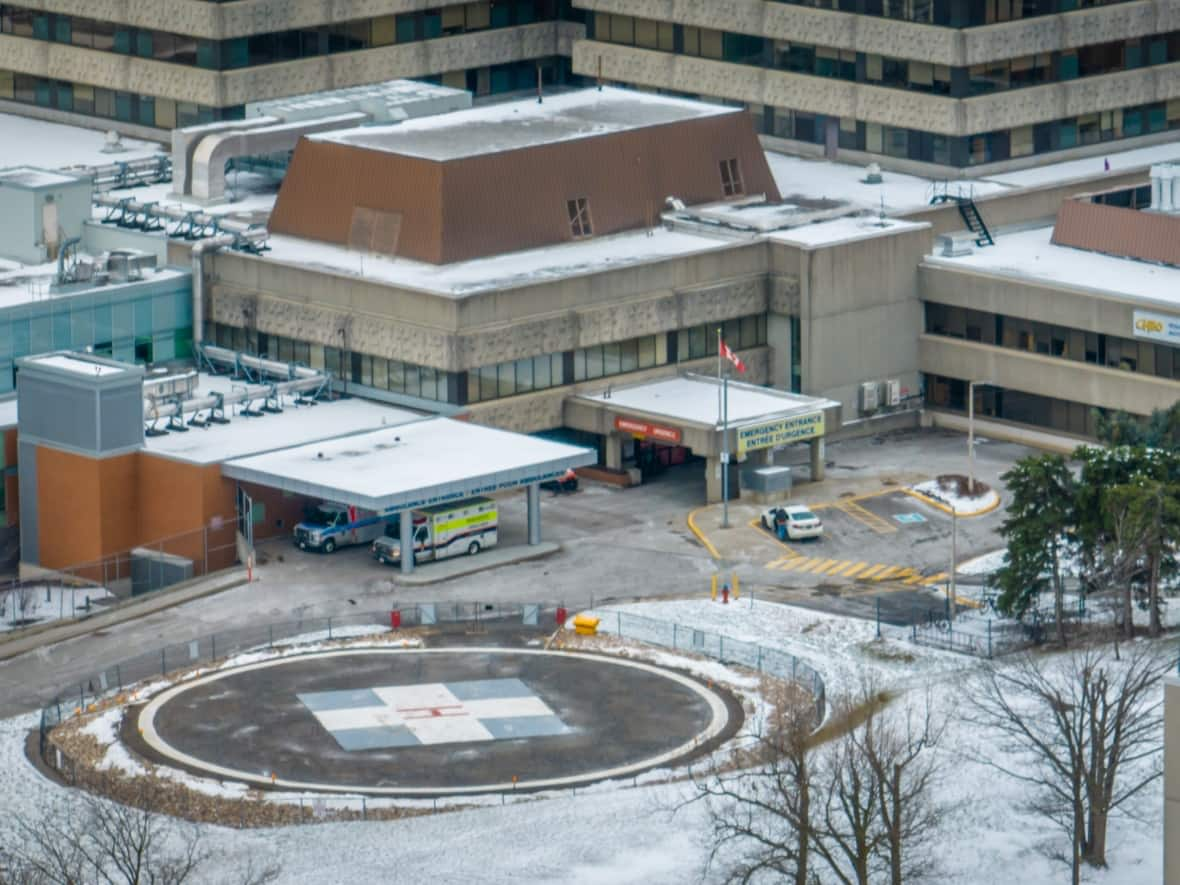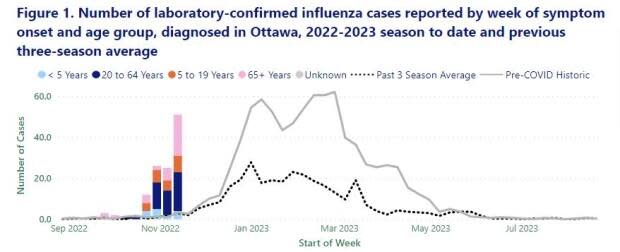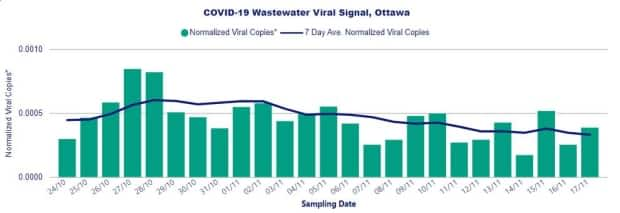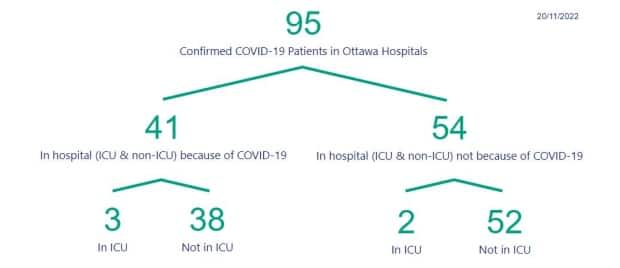Most COVID trends moving in the right direction, but not the flu

Recent developments:
Most of Ottawa's COVID-19 trends are dropping.
Its flu activity is rising.
City's coronavirus wastewater average is at its lowest point of the fall.
Hospitalizations drop outside of Ottawa.
The latest guidance
Officials in Ontario and Quebec say the health-care system, particularly for children, is under extraordinary pressure because of COVID-19, early flu and respiratory syncytial virus (RSV) seasons, and a medication shortage.
They strongly recommend people wear masks indoors. Staying home when sick, keeping hands and surfaces clean and keeping up-to-date with COVID and flu vaccines are also recommended to help keep vulnerable people safe.
Ottawa Public Health (OPH) said Thursday that flu and RSV levels are high, but COVID levels aren't. Flu activity is rising, it added Tuesday.
Ontario and Quebec flu test positivity is increasing and RSV positivity has plateaued.

Wastewater
The weekly average level of coronavirus in Ottawa's wastewater is moderate, according to OPH.
While the research team hasn't updated its page, OPH says as of Nov. 17 the average has been slowly dropping this month back to a level last seen at the end of August.

The research team also shares flu and RSV levels in wastewater.
Tests, outbreaks and deaths
Testing strategies changed under the Omicron variant, meaning many COVID-19 cases aren't reflected in counts. Public health officials now only track and report outbreaks in health-care settings.
Ottawa's COVID test positivity rate is 15 per cent, which has slowly risen for about a week after a steady drop. OPH considers this high.
There are 30 active COVID outbreaks in Ottawa. This is moderate, according to OPH, and has been slowly dropping.
The city health unit reports two flu outbreaks and 38 "other" respiratory outbreaks, nearly all in child-care settings, which is stable.
OPH reported 133 more COVID cases over four days and the deaths of two people age 90 or above with COVID. A total of 963 Ottawa residents who had COVID have died, 353 of them this year.
Hospitals
OPH's count of active, local COVID-19 hospital patients drops to 11 in Tuesday's update. There is one patient in intensive care, which is also a stable number.
The health unit cautions that changes it's making to its data system may affect the hospitalization count, which had a sharp drop around the start of the month.
For example, the hospitalization count was 28 on the main page of the dashboard update on Nov. 11. The count under another tab, which is constantly updated as new paperwork comes in, had 43 patients that day.
There is another count that includes other patients, such as people admitted for other reasons who then test positive for COVID-19, those admitted for lingering COVID-19 complications, and those transferred from other health units.
That number dropped Tuesday, going below 100 for the first time this autumn.

Vaccines
As of the most recent weekly update Nov. 14, 93 per cent of Ottawa residents aged five and up had at least one COVID-19 vaccine dose, 90 per cent had at least two and 61 per cent at least three.
Thirty-one per cent of Ottawans aged 12 and older had at least four.
About 8,600 residents younger than five have had a first dose, which is about 19 per cent of Ottawa's population of that age group. About 3,000, or six per cent, have had two.
Across the region
Spread
Wastewater trends are mixed in Kingston and generally stable across Leeds, Grenville and Lanark (LGL) counties. It's also generally stable in Casselman and Hawkesbury and dropping from a jump in Cornwall and Morrisburg.
Data from other areas is out of date or unavailable.
COVID-19 test positivity rises to around 20 per cent in the Eastern Ontario Health Unit (EOHU) and falls to around 10 per cent in the Kingston area.
Hospitalizations and deaths
Western Quebec's health authority, CISSSO, reports 69 COVID hospitalizations, which is slowly dropping. One of the patients is in intensive care.
Eastern Ontario communities outside Ottawa report a drop to about 40 COVID hospitalizations, with nine of them in intensive care. COVID hospitalizations in the Kingston area fell from 31 to 17 in this weekly update.
That regional count doesn't include Hastings Prince Edward (HPE) Public Health, which has a different counting method. Its count dropped below 10 Tuesday for the first time since August.
The EOHU reported its 136th COVID death of 2022 and its 270th death overall. The Kingston area reported its 100th total death, 78 of them this year.
Health units for LGL and the Belleville areas did not report any more COVID deaths in their weekly updates.
Each local health unit, except Ottawa, has had more reported COVID deaths in 2022 than either 2020 or 2021. Nationally, people dying of COVID in the later months of 2022 have generally been older, living with pre-existing conditions, or undergoing immune-suppressing treatments.
Vaccines
Across eastern Ontario, between 81 and 92 per cent of residents age five and up have received at least two COVID-19 vaccine doses, and between 53 and 65 per cent of those residents have had at least three.


